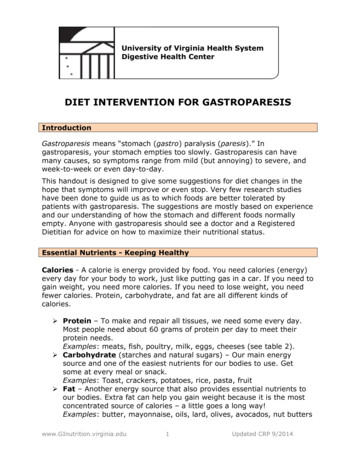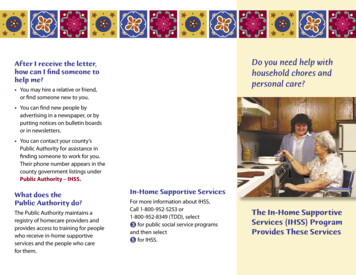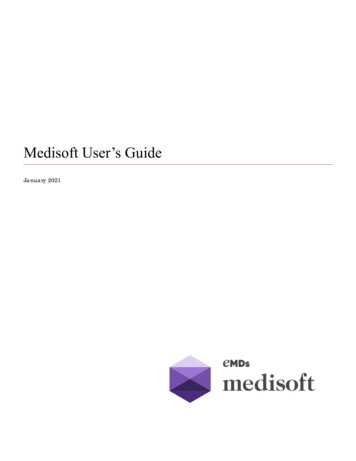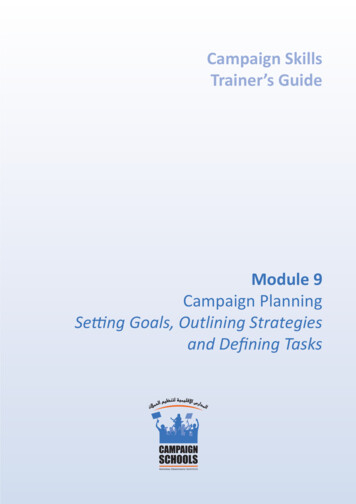
Transcription
THE HELP YOUNEED TO QUITSMOKINGBoehringer Ingelheim Pharmaceuticals, Inc. has no ownership interestin any other organization that advertises or markets its diseasemanagement products and services.A patient educational resource provided byBoehringer Ingelheim Pharmaceuticals, Inc.C Printed on recycled paper in the U.S.A.Copyright 2007, Boehringer Ingelheim Pharmaceuticals, Inc.All rights reserved. (05/07) DM45519BI0000HHW-HIPM0003 (11/10)HCCM0023 (3/15)
FACE THE FACTSABOUT THIS BOOKLET You know smoking is bad for you. You’veprobably thought about quitting. You mayeven have tried to quit. But if you’re stillsmoking, you may need help to quit.This booklet serves as a guide to helpyou become a nonsmoker.This booklet can help you think about why you smoke.It can help you remember why you need to stop.Our simple, step-by-step guide can help you in yourjourney to becoming a nonsmoker. The topics areSmoking is the number-one preventablecause of death in the United States. Smokingdoes great harm to your health. And it harmsthe health of people around you, too. Every timeyou puff on that cigarette, you’re breathing inmore than 4,000 chemicals, mostly poisons,into your lungs. Besides nicotine, there is Formaldehyde (for-mal-da-hide)—used to preserve dead animalsWhy Do I Smoke? . . . . . . . . . . . . . . . . . . . . . . . . 5How Does Smoking Affect Me—and Those Around Me? . . . . . . . . . . . . . . . . . . . . 6Quitting Step-by-Step. . . . . . . . . . . . . . . . . . . . . . 8Step 1: Focus on the Benefits of Quitting . . . . . 8Step 2: Learn When and Why I Smoke . . . . . 12 Cyanide (sy-uh-nide)—used to kill rats Carbon monoxide (car-bun mun-ox-ide)—found in the exhaust fumes from cars DDT—a poison used to kill insects Arsenic—another poisonCigarette smoking is the biggest risk forlung disease. Pipe and cigar smokers arealso at risk.It’s time to help yourself. Do it for your health,your quality of life, and for those who love you.It’s time to stop smoking for good.Step 3: Getting Ready to Quit . . . . . . . . . . . 16Coping With Withdrawal Symptoms. . . . . . . . . . 18Medicines That Can Help Make Quitting Easier. . 20Reminders for Staying on Track. . . . . . . . . . . . . . 22Getting Support and Help . . . . . . . . . . . . . . . . . 24It’s not easy, but it can be done. Many, manypeople have kicked the habit. You can too.This booklet will serve as a guide to help youget started—and stay committed—to do whatyou need to do: Become a nonsmoker.3
WHY DO I SMOKE?People smoke for lots of different reasons.You may have gotten into the smoking habitas a way to Deal with stress, boredom,and/or anger Relax Be social on a night out with friends Control your appetite Feel more alertSmoking is not worth the damage it causes—no matter what.5
HOW DOES SMOKINGAFFECT ME—AND THOSEAROUND ME?Smoking causes damage to your wholebody. If you smoke, you face three typesof health risks:Short term Includes symptoms you mayhave now, such as coughingand trouble breathing If pregnant and smoking, you couldhave a baby with low birth weightLong term Includes diseases you may getover time, such asEnvironmental [en-vi-ron-men-tal]Also called “secondhand smoke,” which containsmore than 50 cancer-causing chemicals Includes possible health problems thatmay occur in people who do not smokebut are around smokers, such as Many diseases, including cancers,heart disease, and lung problems In children: low birth weight,sudden infant death syndrome(SIDS), asthma, and respiratoryand ear infectionsHave any of these things happened in yourown life? Have family members become sickfrom your smoke?If so, don’t wait any longer to quit! Heart disease Stroke Various types of cancer Lung diseases, such as lung cancerand chronic (kron-ick) obstructive(ob-struck-tiv) pulmonary (pull-muhnair-ee) disease, also called COPD,which includes chronic bronchitis,emphysema, or both Cataracts (an eye problem)67
QUITTING STEP-BY-STEPStep 1: Focus on the Benefitsof QuittingIf you’re looking for reasons to quit, there aremany to choose from. Look at this list. Whichare most important to you?After you smoke your last cigarette, yourbody starts to make changes fast. Thesechanges go on for years:20 minutes after you quit, your heartrate drops.12 hours after you quit, the carbon monoxidelevel in your blood drops to normal. Having more energyAfter 2 weeks to 3 months, your heartattack risk begins to drop. Your lungs startto work better. Creating a cleaner and healthier homefor your family1 to 9 months after you quit, you have lessshortness of breath and coughing. Stopping more damage to your lungsAfter 1 year, your chance of getting heartdisease is half that of a smoker. Breathing easier Reducing your chances of gettingdiseases, such as COPD, which includes chronicbronchitis (bronk-eye-tis) andemphysema (em-fuh-zee-muh) Stroke Heart disease such asheart attack, chest pain Cancer (including cancers ofthe lung, throat, bladder, kidney,and pancreas)5 to 15 years after you quit, your chanceof having a stroke is the same as that ofsomeone who never smoked.10 years after you quit, your chanceof dying from lung cancer is half that ofa smoker. Your chance of getting somecancers decreases, including those of the Mouth Throat Esophagus ([ess-ah-fa-gus] food pipe) Reducing the signs of early agingsuch as wrinkles Bladder Having fresh-smelling breath, hair,and clothes Pancreas Saving lots of money Improving your sense of taste and smell8How Quitting Smoking Helps Kidney15 years after you quit, your chance ofgetting coronary heart disease is the sameas that of a nonsmoker.9
Quitting smoking can slow COPDfrom getting worse. It is never toolate to quit smoking.Why It’s Important to Quitat ANY AgeSome older adults may not see whythey should quit smoking at their age.But quitting can improve your healthat any age. If you’re an older adult,quitting smoking can Reduce your chance of dying fromheart disease and lung cancer Improve your circulation Increase your energy Help you to breathe easier1011
Step 2: Learn When andWhy I SmokeSmoking is a habit. It’s something you’vegotten used to doing. You may do italmost without thinking. To break thathabit, you need to know why you do it.What things (“irritants”) make you keepreaching for that cigarette?Look at this list each time you have acigarette. Put a checkmark in the box nextto the statement(s) that is a trigger for youto light up.12rGetting up in the morningrDrinking coffeerFinishing a mealrTaking a break from workingrDrivingrSpending time with friendswho smokerDrinking alcoholrFeeling goodrNeeding to relaxrFeeling angryrFeeling boredrWanting to feel more at easein a social situationAlso ask yourself: Do I smoke morerIn the morning?rIn the afternoon?rIn the evening?rOn weekends?rOn weekdays?13
Instead of smoking Track it!For the next few days, write down eachcigarette you smoke (example of formbelow). Keep the form with you. Each timeyou light up, write down The time When you feel stressed out Take a walk Listen to soothing music Do stretching exercises When you’re driving What you are doing Chew gum How you are feeling Listen to a book on tape Sing along with the radioCigarettes, cigars,or pipes smokedTime of day and whatyou were doingReason for smoking this cigarette,cigar, or pipe110:30 A.M., workingstressed out3ELP4AM57 Brush your teeth right away Have a glass of orange juice26 When you get up in the morningEX8 Do stretches, deep breathing,or yoga When you’re bored Read a magazine or book Call a friend Watch a movie910Please refer to the Quit SmokingDiary.Action Plan:Get a small notebook. Write down ideasfor things to do instead of smoking.Think of options for everything that maymake you want to smoke, such as timeof day or feeling.Keep this notebook in your purse or pocket.Then look at these ideas when you have theurge to pick up a cigarette.1415
Step 3: Getting Ready to QuitGive yourself at least 2 weeks to plan forquitting. Here are some things you can dofor the best chance of success.Pick a quit date and stick to it.Make a plan. Decide how you will quit.Ask your healthcare practitioner for help.You may Go “cold turkey” (quit all at once) Cut back gradually on the numberof cigarettes you smoke each day Join a quit-smoking program orsupport group Consider taking medicines callednicotine replacement products that canhelp make quitting easier (see pages20 to 21). Talk to your healthcarepractitioner about whether these areright for you. If you do use them, besure to have them ready to start onyour quit dateMake lists. These can help you stickto your plan. Write down All the reasons why you want to quit Things, such as drinking coffeeor talking on the phone, thatmay bring on the urge to smoke—and how you avoid or deal withthese situationsPut these lists where you will see them everyday, as on your bathroom mirror.Plan for success. Do all you can to planfor success: Ask friends and family for support.Ask those that smoke to join youin quitting. Or ask them to at leastnot smoke in front of you Get rid of any things—in your home,office, and car—that have to do withsmoking, such as Cigarettes Ashtrays Lighters MatchesYou may want to clean these areas.That way you can get rid of the smell ofsmoke, too. Learn what withdrawal symptoms youmay get. Find ways to cope with them1617
COPING WITHWITHDRAWAL SYMPTOMSWithdrawing from smoking can be hard. Not everyonehas the same symptoms. You need to plan how you candeal with yours. Here are some ideas:Withdrawal SymptomsWays to CopeFeeling nervous or on edge Take deep breaths Do some yoga or meditate Take a walk outsideFeeling tired Take a nap Get a good night’s sleepHaving trouble sleeping Stop caffeine drinks latein the day Read a book before bedtimeIncreased desire to eat Drink water and liquidslow in calories* Eat vegetables and otherhealthy foods Chew sugar-free gumTrouble staying focused Take a walk to relax Try not to do anything toodemanding during the firstcouple of weeksCraving a cigarette Work on a hobby orother interest Breathe deeply Take a shower Remember that the cravingwill passConstipation or upset stomach Add fruit, cereals, and grainsto your diet Increase liquids in your diet* See a dietitian (die-eh-tih-shun)if you need more help18*Call your doctor if you have fluid limits. Find out how much you can drink.Remember, your body is getting used to beingsmoke-free. These uncomfortable feelings willpass in time. Then you can enjoy life more.
MEDICINES THAT CAN HELPMAKE QUITTING EASIERThings to Know AboutNicotine Replacement ProductsThere are medicines that help you quit smoking.They may improve your chance for success. Ask yourhealthcare practitioner or pharmacist about them.Your health plan may cover them.Don’t use nicotine replacement whileyou are still smoking. You shouldstart them on your quit date.Some of the choices include:Nicotine replacement productsThese medicines have nicotine in them. That may reduceyour withdrawal symptoms. They come in several forms.See the following chart:Be sure to ask your healthcare practitionerbefore you take these products if you Are under age 18 Are breastfeeding, pregnant, or tryingto become pregnant Have other medical problems Are taking other scriptionsNoComments Releases nicotine as you chew Takes several minutes for nicotineto reach your brainNasal spray Yes Gets nicotine into your bloodstreamthrough your nose Provides a fast nicotine “hit”InhalerYes A small device you hold likea cigarette Releases nicotine into your mouthwhen you breathe inPatchNoNon-nicotine treatmentThere are also pills that don’t have nicotine.These may help reduce withdrawalsymptoms, too.Some other medications and some conditionsmay prevent you from taking the pill. Tell your doctor about any othermedications you are taking and allmedical conditions you have The non-nicotine pills should be startedabout a week before you quit smoking Placed on your skin Releases nicotine slowly and evenlythrough the layers of your skin intoyour bloodstreamLozengeNo Releases nicotine as lozengedissolves in your mouth2021
Make It Easy on Yourself:REMINDERS FOR STAYINGON TRACKOnce you choose a quit plan, you cando some things that can make it go moresmoothly. And you can avoid some thingsthat can be problems.Do: Drink lots of fluids (non-caffeine drinks)if you have no fluid limits. If you havefluid limits, call your doctor. Find outhow much you can drinkDo NOT: Be around people who are smokingor places that may bring up the urgeto smoke Drink alcohol Overeat Let your moods get to you. If you’refeeling down, call a friend. If you feelstressed, try deep breathing or getsome fresh airIf you’ve tried to quit in the past, think aboutwhat helped and what did not. Then findways to stay on track all the way this time. Get plenty of rest Get your mind off smoking. Workon a hobby or go to a museumIf You Get off Track Start a fitness program. Talk withyour healthcare practitioner firstPeople often have to make several triesto quit smoking for good. If you slip up andsmoke one time or more, don’t feel as if youfailed. Here are some tips for what youcan do: Change your routine. For example,instead of smoking after a meal,brush your teeth Cope with stress. Try soft music,a hot bath, or a yoga class If you’ve been trying to quit onyour own, join a support group.Or go for counseling Plan fun things to do. You couldsee a movie with friends, reada new book, or get a massage Try using medicine, or use a differentmedicine than you used before See your dentist for a cleaningto get rid of smoking stains onyour teeth Reward yourself. Buy yourself atreat, such as flowers or a new CD,with some of the money you saveby not smoking. Or set a goal, suchas a vacation22 Think about what made you startsmoking again. And think of waysyou can deal with the urge betternext time23
GETTING SUPPORT AND HELPYou can get helpful tips for quitting smoking from Books Audio tapes Video tapes and DVDs Sources on the Internet, includingSmokefree.govA program of The National Cancer Institute,The American Cancer Society, andCenters for Disease Control and Prevention1-800 - 784 - 8669www.smokefree.gov/guideUS Department of Health and Human Services1- 301- 443- 4000www.surgeongeneral.gov/tobacco/National Heart, Lung, and Blood Institute (NHLBI)1- 301- 592-8573www.nhlbi.nih.govNational Cancer InstituteSmoking cessation fact sheet1- 800 - 422- cessationCenters for Disease Control and Prevention1- 800 - 232- 4636www.cdc.gov/tobacco/how2quit.htm24
It's time to stop smoking for good. It's not easy, but it can be done. Many, many people have kicked the habit. You can too. This booklet will serve as a guide to help you get started—and stay committed—to do what you need to do: Become a nonsmoker.











